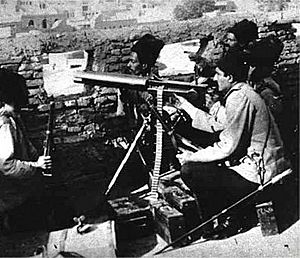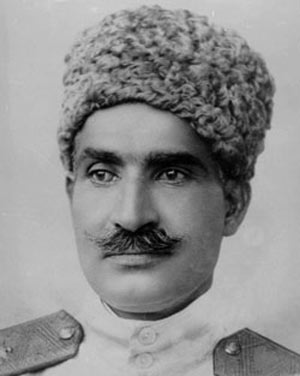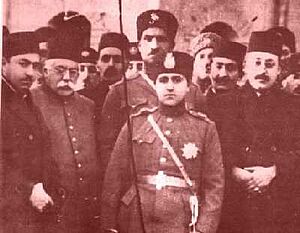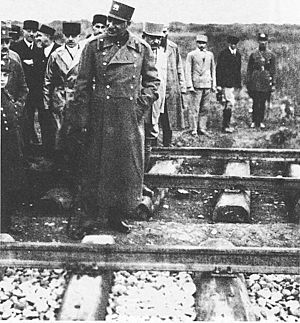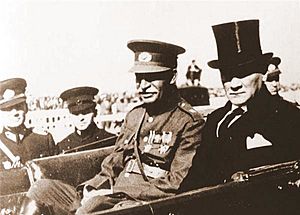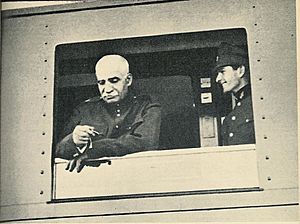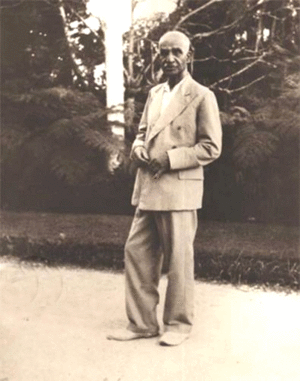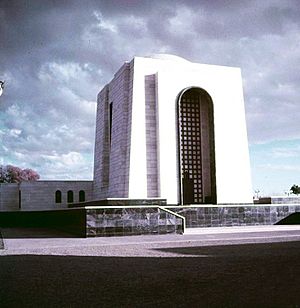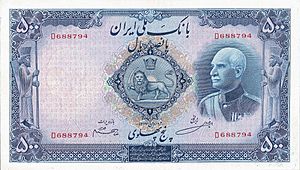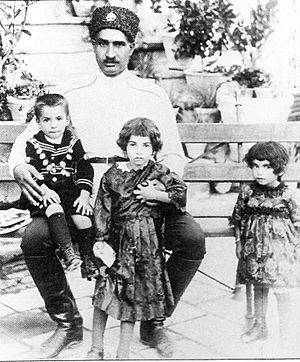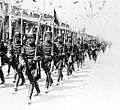Reza Shah facts for kids
Quick facts for kids Reza Shah Pahlavi |
|||||
|---|---|---|---|---|---|
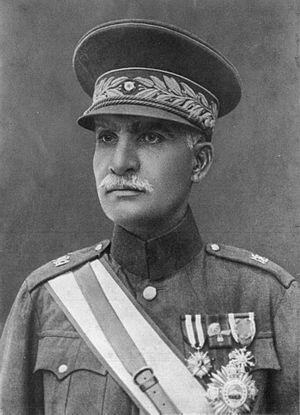
Reza Shah in the 1930s
|
|||||
| Shah of Iran | |||||
| Reign | 15 December 1925 – 16 September 1941 | ||||
| Coronation | 25 April 1926 | ||||
|
Prime Ministers
|
See list
Mohammad-Ali Foroughi Hassan Mostowfi Mehdi Qoli Hedayat Mohammad-Ali Foroughi Mahmoud Jam Ahmad Matin-Daftari Ali Mansur Mohammad-Ali Foroughi |
||||
| Predecessor | Ahmad Shah Qajar | ||||
| Successor | Mohammad Reza Shah | ||||
| Prime Minister of Iran | |||||
| In office | 28 October 1923 – 1 November 1925 | ||||
| Predecessor | Hassan Pirnia | ||||
| Successor | Mohammad-Ali Foroughi | ||||
| Minister of War | |||||
| In office | 24 April 1921 – 1 November 1925 | ||||
| Predecessor | Masoud Kayhan | ||||
| Successor | Amir Abdollah Tahmasebi | ||||
| Born | 15 March 1878 Alasht, Savadkuh, Mazandaran, Sublime State of Persia |
||||
| Died | 26 July 1944 (aged 66) Johannesburg, Union of South Africa |
||||
| Burial | 1944 Al-Rifa'i Mosque, Cairo, Egypt; 7 May 1950 Mausoleum of Reza Shah, Shah Abdol-Azim Shrine, Rey, Iran |
||||
| Spouse |
Maryam Savadkoohi
(m. 1895; died 1911)Tadj ol-Molouk Ayromlu
(m. 1916)Turan Amirsoleimani
(m. 1922; div. 1923)Esmat Dowlatshahi
(m. 1923) |
||||
| Issue | Princess Hamdamsaltaneh Princess Shams Mohammad Reza Shah Princess Ashraf Prince Ali Reza Prince Gholam Reza Prince Abdul Reza Prince Ahmad Reza Prince Mahmoud Reza Princess Fatemeh Prince Hamid Reza |
||||
|
|||||
| House | Pahlavi | ||||
| Father | Abbas-Ali Khan | ||||
| Mother | Noush-Afarin | ||||
| Signature | |||||
| Military career | |||||
| Allegiance | Sublime State of Persia Imperial State of Iran |
||||
| Service/ |
Persian Cossack Brigade | ||||
| Years of service | 1894–1921 | ||||
| Rank | Brigadier general | ||||
Reza Shah Pahlavi (born Reza Khan; 15 March 1878 – 26 July 1944) was an important Iranian leader. He was a military officer and politician who became the first Shah (King) of the Pahlavi dynasty. He ruled Iran from 1925 until 1941. His son, Mohammad Reza Pahlavi, became the last Shah of Iran.
Reza Shah is known for bringing many changes to Iran. He introduced social, economic, and political reforms that helped create the modern country we know today. Because of this, he is often called the founder of modern Iran.
When he was 14, Reza Khan joined the Persian Cossack Brigade, which was a special military unit. He quickly rose through the ranks. By 1921, he was leading the entire Cossack Brigade. He marched his troops to Tehran, the capital city, and took control of the government. He then became the commander of the army and the Minister of War.
Two years later, Reza Pahlavi became Iran's Prime Minister. In 1925, the country's assembly decided to make him the new Shah. They removed the last ruler of the Qajar dynasty, Ahmad Shah Qajar. Reza Shah then started the Pahlavi dynasty, which ruled Iran until 1979.
Years after his death, in 1950, Iran's assembly gave him the special title Reza Shah the Great.
People still have different opinions about Reza Shah's rule. Some say he was vital for making Iran a strong, modern country. Others say his rule was too strict and that he didn't help everyone in Iran equally. He also tried to unite different groups in Iran under one culture, which sometimes caused problems for various ethnic groups.
Contents
Early Life and Military Career

Reza Shah Pahlavi was born in 1878 in a town called Alasht in Mazandaran Province. His father, Abbas-Ali Khan, was a military officer who died when Reza was only eight months old. His mother, Noush-Afarin, was from Georgia. After his father's death, Reza and his mother moved to Tehran.
When Reza was 16, he joined the Persian Cossack Brigade. He was a very skilled soldier. He quickly moved up in rank, becoming a first lieutenant in 1911 and a captain in 1912. By 1915, he was a colonel. Eventually, he became a brigadier general and the last Iranian commander of the Cossack Brigade.
In 1919, he chose the last name "Pahlavi" for himself. This name later became the name of the royal family he started.
How Reza Shah Gained Power
After the Russian Revolution, Iran faced many challenges. British and Soviet forces had a lot of control over different parts of the country. This led to a difficult political situation in Tehran.
In January 1921, a British general named Edmund Ironside promoted Reza Khan to lead the entire Cossack Brigade. About a month later, Reza Khan led his troops to Tehran and took control of the capital. This event is known as the 1921 Persian coup d'état.
He made the old government step down and appointed Zia ol Din Tabatabaee as the new Prime Minister. Reza Khan's first job in the new government was commander of the Iranian Army and Minister of War. He was known as Sardar Sepah, meaning Commander-in-Chief of the Army.
The British government helped with the 1921 coup. They wanted to stop the Bolsheviks (from Russia) from gaining too much power in Iran. This was important because of the threat to British lands in India.
After the coup, Reza Khan spent 1921 making sure Iran was safe from internal rebellions. He dealt with groups that were fighting against the new government.
Becoming the Shah
As Minister of War, Reza Khan became very powerful. He had some disagreements with the Prime Minister, Zia ol Din Tabatabaee. It became clear that Reza Khan was the one truly in charge.
By 1923, Reza Khan had made Iran much more stable. When he returned to Tehran, he was made Prime Minister. The old Shah, Ahmad Shah, then left Iran for Europe.
In October 1925, Reza Khan convinced the Iranian parliament (Majlis) to remove Ahmad Shah from power. He then planned to make Iran a republic, like Turkey had done. However, he changed his mind because of opposition from the British and religious leaders.
On 12 December 1925, the Majlis declared him the new Shah (King) of Iran. Three days later, he took his oath. His official coronation happened later, on 25 April 1926. At that time, his son, Mohammad Reza Pahlavi, was named the crown prince.
Reza Shah's Rule and Modernization
Reza Shah wanted Iran to be a modern country. He aimed to reduce the influence of religious leaders and bring in new ideas. He wanted Iran to have modern schools, for women to be more involved in society, and to build modern industries and transportation.
He believed in a strong, central government. He preferred to make decisions himself rather than consulting with many politicians.
His rule can be seen in two parts. From 1925 to 1933, he worked with educated Iranians to start big projects. These included building railways, creating a modern justice system, and changing traditional clothing and customs. After 1933, he took even more direct control.
Modernizing Iran's Infrastructure and Society
During Reza Shah's 16 years as ruler, Iran saw many big changes.
- Large road construction projects were started.
- The Trans-Iranian Railway was built, connecting the Caspian Sea to the Persian Gulf.
- Modern education was introduced.
- The University of Tehran, Iran's first university, was established.
- The government also sent many Iranian students to study in Europe.
- The number of modern factories grew significantly.
Reza Shah also supported the "Women's Awakening" movement. This movement encouraged women to remove the chador (a traditional veil) and participate more in public life. This was a big change and faced some opposition from religious leaders.
Reza Shah was also the first Iranian ruler in 1400 years to visit a Jewish synagogue in Isfahan. This act was important for Iranian Jews and made them feel more respected. He opened new jobs for Jewish people and allowed them to leave their traditional living areas.
He also discouraged old customs he considered backward, like using camels for transport. He banned traditional religious clothing and chadors, encouraging Western-style dress instead.
Parliament and Government Officials
During Reza Shah's rule, parliamentary elections were not truly democratic. The Shah and his officials largely decided who would be elected.
He also removed some of his ministers from power. For example, his Minister of Imperial Court, Abdolhossein Teymourtash, and the Minister of Finance, Prince Firouz Nosrat-ed-Dowleh III, faced accusations and were removed from their positions. These events meant that Reza Shah took on even more responsibility for governing the country.
Changing the Country's Name to Iran
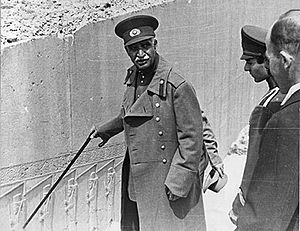
For a long time, Western countries called Iran "Persia." In 1935, Reza Shah asked foreign countries to use the name Iran in all official communications. "Iran" means "Land of the Aryans" and is the name the country's own people used. This change helped to unify the country's identity.
Even though the main language was Persian, many people in Iran were from different ethnic groups. Using "Iran" helped to include everyone, not just those who identified as "Persian."
Clashes with Religious Leaders
As Reza Shah's power grew, he often disagreed with Iran's religious leaders and devout Muslims.
- In 1928, he entered a holy shrine in Qom and confronted a cleric.
- Later that year, he made a law requiring most people to wear Western clothes, including hats with brims. This angered devout Muslims because it made it hard to touch their foreheads to the ground during prayer.
- He also encouraged women to stop wearing the hijab. Female teachers were not allowed to wear head coverings in school.
- He allowed men and women to mix in public places like colleges, cinemas, and hotels.
- He limited public mourning ceremonies to one day and asked mosques to use chairs instead of people sitting on the floor.

By the mid-1930s, many religious leaders were very unhappy with Reza Shah's policies. In 1935, a rebellion broke out in a holy shrine in Mashhad. People protested the Shah's changes and taxes. The army had to step in to end the protest, which led to many casualties.
After this event, Reza Shah made his changes even stronger. He issued the Kashf-e hijab decree, which banned the chador and ordered all women to appear in public without head coverings.
Foreign Relations and Influence
Reza Shah also changed Iran's foreign policy. He wanted to reduce the influence of foreign powers, especially Britain and Russia.
One of his first actions after taking power was to change the treaty with the Soviet Union. He also tried to balance British influence by working with other countries.
In 1934, he visited Turkey and met with its president, Mustafa Kemal Atatürk. They discussed their countries' modernization efforts.
Reza Shah also challenged British control over Iran's oil. In 1932, he canceled the oil agreement with the Anglo-Persian Oil Company (APOC), which was largely owned by the British government. He wanted a better deal for Iran. After discussions, a new agreement was signed in 1933, giving Iran a better share of the profits.
He hired American experts to help set up modern financial systems. He also bought ships from Italy and brought in German technicians for various projects. He was careful not to let any one foreign country have too much control over Iran. He also made sure that foreign advisors worked for the Iranian government, not for their own countries.

In 1928, he ended old agreements that gave Europeans special legal rights in Iran. He also moved control of Iran's money and telegraph system from foreign companies to Iranian ones. He even limited foreigners from owning land or traveling freely in the provinces.
Some people criticized his development plans. For example, the north-south railway he built was seen as more useful for the British military than for Iran's economy.
Reza Shah tried to create alliances with neighboring countries like Turkey. However, the death of Atatürk in 1938 and the start of World War II prevented these plans from fully happening.
World War II and Forced Abdication
In August 1941, during World War II, the Allied powers (the United Kingdom and the Soviet Union) invaded and occupied neutral Iran. They did this without declaring war. They needed to secure a supply route to send war materials to the Soviet Union.
Iran's military, which Reza Shah had worked hard to build, quickly fell apart. Many Iranian commanders were unprepared, and some even secretly helped the British. Tehran, the capital, faced air raids, and people feared the Soviets. The royal family, except for the Shah and the Crown Prince, fled the city.
Reza Shah was very upset by the army's collapse. He ordered his military to stop fighting and began talks with the British and Soviets. The Allies demanded that Iran expel all German citizens and close their embassies. Reza Shah tried to secretly help German nationals leave the country.
Because of his defiance, the Soviet army moved to occupy Tehran on 16 September. Fearing for his life, Reza Shah decided to step down from his throne. He announced his abdication as the Soviets entered the city on 17 September.
The British initially wanted to bring back the old Qajar dynasty. However, the Qajar heir lived in Britain and didn't speak Persian. So, with help from the former Prime Minister Mohammad Ali Foroughi, Crown Prince Mohammad Reza Pahlavi became the new Shah of Iran.
Iran became known as "The Bridge of Victory" by Winston Churchill because of its important role in supplying the Allies during the war.
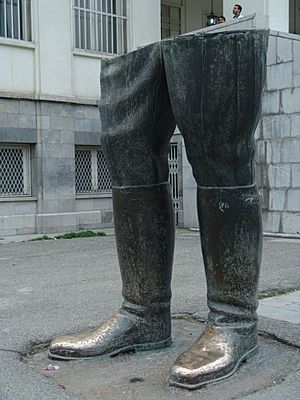
Reza Shah was forced by the British to leave Iran. He went into exile, and his son Mohammad Reza Pahlavi took over as Shah on 16 September 1941.
Death and Legacy
Like his son, Reza Shah died while in exile. After he stepped down, the British took him and his children to Mauritius, an island nation. Later, he was moved to Johannesburg, South Africa. He died there on 26 July 1944, at the age of 66, from a heart problem.
After his death, his body was taken to Egypt and kept in a mosque in Cairo. In May 1950, his remains were brought back to Iran. He was buried in a special mausoleum built for him in the town of Ray, near Tehran. The Iranian parliament later gave him the title "the Great."
After the Iranian Revolution in 1979, Reza Shah's mausoleum was destroyed. However, in 2018, a mummified body believed to be his was found near the old mausoleum site in Tehran. Officials confirmed it belonged to Reza Shah and was reburied in the same area.
Key Changes and Achievements
During Reza Shah's rule (1923-1941), many new ideas and laws were introduced. Some of his important achievements include:
- Bringing all parts of Iran under a strong central government.
- Creating Iran's first modern justice system.
- Starting the first national health care system and public hospitals.
- Rebuilding the Iranian Gendarmerie (police force) to keep law and order.
- Building the Trans-Iranian Railway, connecting the Caspian Sea to the Persian Gulf.
- Making Iran's forests and jungles national property.
- Creating a modern Iranian military.
- Starting Iran's first radio stations.
- Founding the national Museum of Iran.
- Restoring Iran's historical sites, like the tombs of famous poets Ferdowsi and Hafez.
- Celebrating the 1000th anniversary of Ferdowsi's birth, who helped save the Persian language.
- Creating the Academy of Persian Language and Literature to protect Iran's official language.
- Starting the first scientific digs at Persepolis, an ancient capital.
- Creating Iran's first national bank, Bank Melli Iran, and other banks.
- Establishing the University of Tehran, the first university in Iran.
- Providing scholarships for Iranian students to study in Europe.
- Reducing corruption among government workers by paying them on time.
- Creating the first national school system and schoolbooks.
- Establishing the first kindergarten and school for deaf people.
- Creating the Iran Scout Organization.
- Introducing birth certificates and ID cards for all Iranians.
- Building Iran's first airplane factory and airport (Mehrabad airport).
- Changing Iranian currency from Toman to Rial.
- Restoring the Persian calendar as the official calendar.
- Issuing the Kashf-e hijab decree in 1936, which banned veils and some traditional male clothing.
- Asking foreign countries to use "Iran" instead of "Persia" in official letters in 1935.
- Rebuilding old cities.
- Ending slavery and harems.
Family Life
Reza Shah had four wives and many children.
- His first wife was Maryam Savadkoohi, his cousin. They had one daughter, Princess Hamdamsaltaneh Pahlavi.
- His second wife was Nimtaj Ayromlou, later known as Tadj ol-Molouk. She became his official queen. They had four children: Princess Shams Pahlavi, Mohammad Reza Shah Pahlavi (who became the next Shah), Princess Ashraf Pahlavi, and Prince Ali Reza Pahlavi.
- His third wife was Turan Amirsoleimani. They had one son, Prince Gholam Reza Pahlavi.
- His fourth and last wife was Esmat Dowlatshahi. She was his favorite wife and went with him into exile. They had five children: Prince Abdul Reza Pahlavi, Prince Ahmad Reza Pahlavi, Prince Mahmoud Reza Pahlavi, Princess Fatemeh Pahlavi, and Prince Hamid Reza Pahlavi.
List of Prime Ministers Under Reza Shah
- Mohammad Ali Foroughi (1st Term: 1925–1926)
- Mostowfi ol-Mamalek (6th Term: 1926–1927)
- Mehdi Qoli Hedayat (1927–1933)
- Mohammad Ali Foroughi (2nd Term: 1933–1935)
- Mahmoud Jam (1935–1939)
- Ahmad Matin-Daftari (1939–1940)
- Ali Mansur (1940–1941)
Titles and Honors
After becoming the Shah of Iran, he ordered everyone to call him "Reza Shah Pahlavi." In 1950, after his death, the National Consultative Assembly gave him the title "Reza Shah the Great."
He also received honors from other countries:
- Czechoslovakia: Order of the White Lion (1935)
- Denmark: Order of the Elephant (1937)
- Sweden: Royal Order of the Seraphim (1934)
Images for kids
See also
 In Spanish: Reza Shah para niños
In Spanish: Reza Shah para niños


